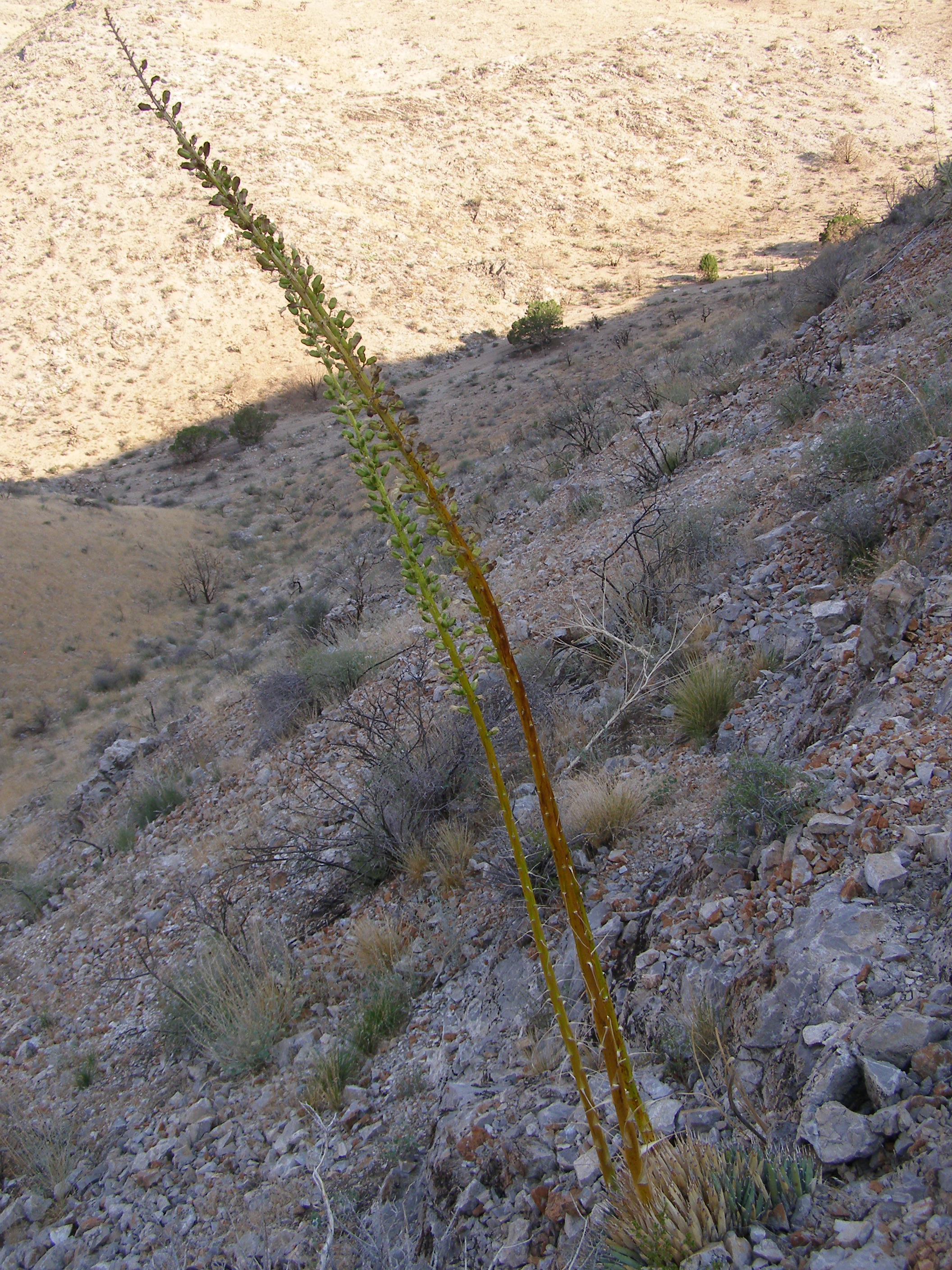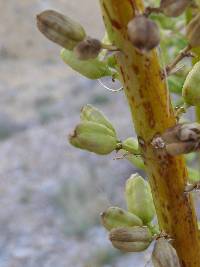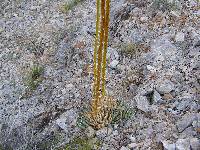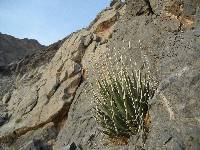Agave utahensis
|
|
|
|
Family: Asparagaceae
Utah agave, more...Utah Century-Plant
|
Plants acaulescent, suckering or not; rosettes solitary or sparingly cespitose, 1.5-6 × 1.5-10 dm. Leaves ascending, 12-50 × 1-5.5 cm; blade grayish green to yellowish green or green, without bud-prints, linear-lanceolate or lanceolate, stiff, adaxially plane or concave toward apex, abaxially convex toward base; margins straight or undulate, nonfiliferous, conspicuously armed, horny from distalmost teeth to apical spine, teeth single, 2-12(-15) mm, 1-4 cm apart, rarely absent; apical spine light gray to ivory white, acicular or subulate, 2-20 cm. Scape 1.7-5 m. Inflorescences spicate, racemose or narrowly paniculate, open to densely flowered; bracts caducous, narrowly triangular, 4-8 cm; lateral branches 50+, horizontal to slightly ascending, comprising distal 1/2-2/3 of inflorescence, shorter than 10 cm. Flowers 2-12 per cluster, erect, urceolate, 2.3-4.3 cm; perianth yellow, tube campanulate, 1-4 × 6.5-11.5 mm, limb lobes connivent, erect, subequal, 7-12 mm; stamens slightly exserted; filaments inserted at or 1-3 mm above base of perianth tube, erect, white, 1.3-2.4 cm; anthers pale yellow, 5-12 mm; ovary 1.2-2.9 cm, neck constricted, 3.5-8.5(-10) mm. Capsules pedicellate, oblong to ovoid, 1-2.5 cm, apex beaked. Seeds 2-4 mm. Plant: perennial scapose herb; Rosettes 15-60 cm high, 20-100 cm broad, open to dense and compact, single to caespitose Leaves: several to numerous, 12-50 cm long, 2.5-5.5 cm wide, linear-lanceolate to lanceolate, attenuate to long-attenuate, stiff, straight, falcate, or upcurving, planar to concave towards apex, convex below, yellow-green, green, or bluish-gray glaucous, the margins straight; teeth 2-5 mm long, 1-4 cm apart, blunt, thick, light gray to white, with conspicuous brown ring at base, friable, or rarely absent; interstitial teeth absent; terminal spine 2-20 cm long, subulate, decurrent to upper teeth, openly grooved above, light gray or white INFLORESCENCE: scape 1.5-5 m tall, spicate, racemose, or narrowly paniculate, with several to numerous conspicuously flattened lateral branchlets up to 10 cm long in upper ½ of flowering stalk, the stalk slender to thickish, green Flowers: in clusters of 2-12, 23-43 mm long, urceolate, fragrance not discernable; tepals subequal, 7-12 mm long, 3-5(-7) mm wide, linear, conduplicate, the outer ones strongly overlapping the inner ones, all persistently erect, connivent, strongly clasping the filaments, deep yellow; filaments 13-24 mm long, inserted at base of tube or 1-3 mm above the base, white, the anthers 5-12 mm long, deep yellow, aging yellowish-orange; ovary 12.5-29 mm long with a constricted neck 3.5-8.5(-10) mm long, yellowish-green to chartreuse-green, the style 18-21 mm long when stigma is receptive, white; floral tube 1-4 mm high, 6.5-11.5 mm wide, bulging at tepal bases, urceolate, yellowish-green to charteuse-green Fruit: capsules, ovoid to oblong, 1-2.5 cm long, 1-1.5 cm broad, short-beaked; SEEDS 2-4 mm long, 3-4 mm wide, thick REFERENCES: Hodgson, Wendy. 1999. Agavaceae. Ariz. - Nev. Acad. Sci. 32(1). Common Name: Utah agave Duration: Perennial Nativity: Native Lifeform: Succulent Wetland Status: None General: Perennial scapose succulents; plants acaulescent; rosetted solitary or sparsely clustered, 15-60 cm tall, 15-100 cm wide; roots fibrous, thick. Leaves: Basal, forming a rosette, ascending, narrowly lanceolate, 10-50 cm long, 1-6.5 cm wide, green, yellowish green, or glaucous, flat or concave above towards the tip, convex below towards the base, margins straight or wavy, bearing distinct teeth 2-12 mm long, 1-4 cm apart, apex spine- tipped, the spine awl- to needle-shaped, 2-20 cm long. Flowers: Inflorescence a panicle, open to dense, with 27-48 flowers borne in umbel-like clusters; flowering stalk 2-6 m tall; bracts of the inflorescence triangular, 3-10 cm long, persistent; flowers pink, red, or orange in bud, yellow to yellowish green at time of flowering; perianth campanulate, 6-18 mm long; tepals 6, fused at the base; stamens 6, long-exserted; flowers June-August. Fruits: Loculicidal capsule, oblong to ovoid, 1-2.5 cm long, pedicellate, apex beaked; seeds obovoid, 2-4 mm long, flattened, becoming round, black. Ecology: Dry slopes, mesas, hillsides; 900-2300 m (3000-7500 ft); Mohave and Coconino counties; southwestern U.S. Notes: Agave utahensis is a host plant for the Mojave giant skipper butterfly. The Havasupai make brushes and brooms from this species, and the Navajo use the fibers to make blankets. |





